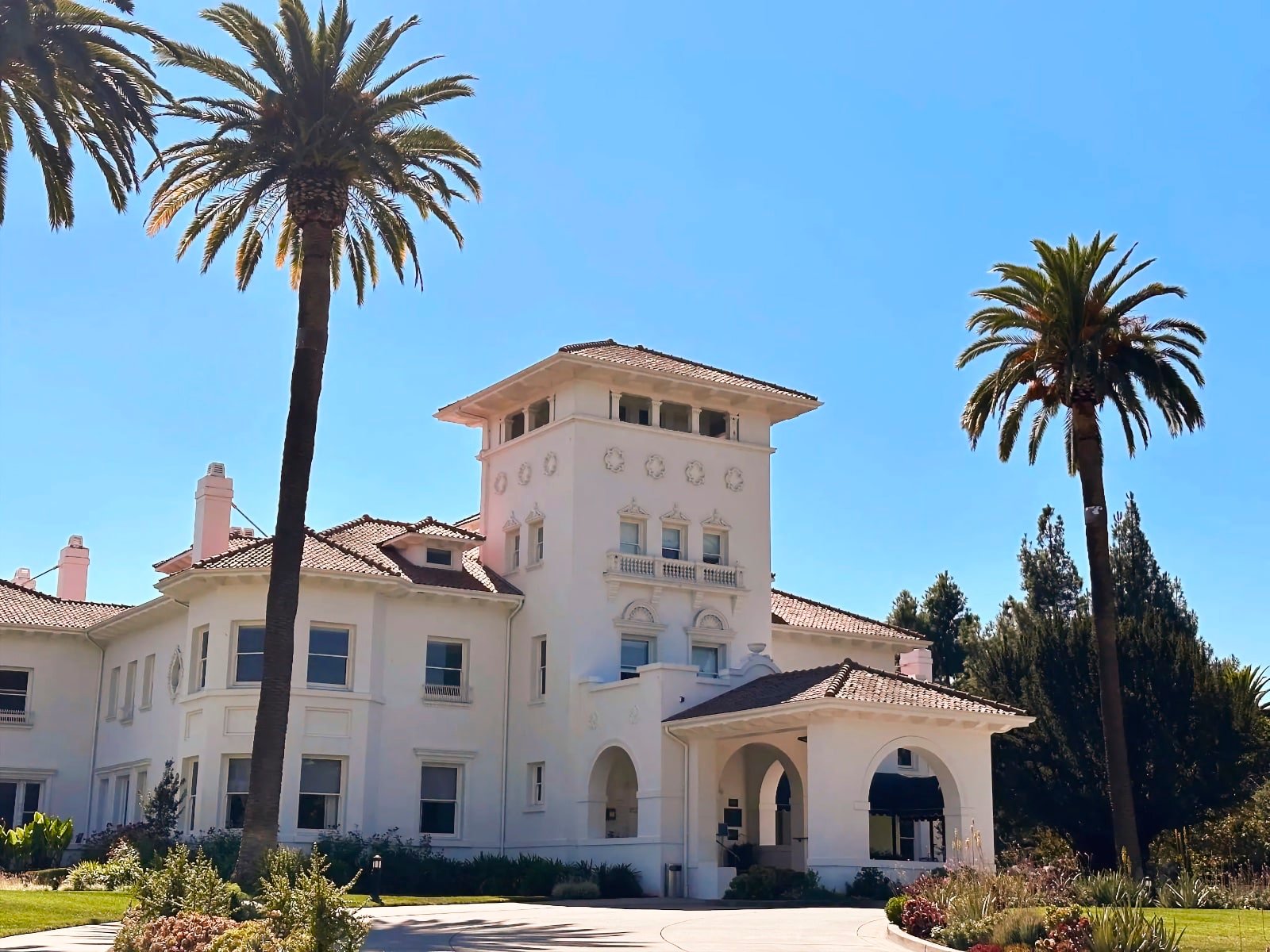Set foot in the timeless beauty of the famous mansions of Silicon Valley, each echoing a unique blend of history, architecture, and grandeur, with a charm that always stands undiminished.
The historic mansions of Silicon Valley, spanning from the 1850s to the 1950s, are remarkable monuments that reflect the area’s transformation from agricultural lands to a hub of technological innovation and affluence. This overview delves into the architectural splendor, the economic forces, and the prominent figures behind these grand residences.
Early Beginnings (1850s-1900s)
The genesis of Silicon Valley’s mansions coincides with California’s Gold Rush era in the mid-19th century. The influx of wealth brought by gold mining and related industries led to the construction of opulent homes by the newly minted elite. These early mansions were characterized by Victorian and Neo-classical styles, embodying the grandeur and optimism of the era. Notable examples include the Ainsley House in Campbell and the Rengstorff House in Mountain View.
The Rise of Agriculture and Industry (1900s-1930s)
As the 20th century progressed, Silicon Valley, then known as the “Valley of Heart’s Delight,” was famed for its fruit orchards and agricultural bounty. Wealth generated from agriculture, along with burgeoning industries, fueled the construction of grand estates. Prominent figures like James Duval Phelan, a banker and mayor of San Francisco, built majestic homes such as the Villa Montalvo. These residences often featured Mediterranean Revival and Beaux-Arts styles, reflecting the era’s architectural trends.
The Impact of The Great Depression and World War II
The Great Depression and World War II brought significant economic challenges, yet some mansions still rose during this period. The economic resilience of certain industrialists and entrepreneurs allowed them to invest in lavish properties. An example is the Filoli Estate in Woodside, built by William Bowers Bourn II, a prominent gold mine owner and the president of Spring Valley Water Company. Post-war, the region saw a shift as military and government funding started pouring into technology and defense industries, setting the stage for Silicon Valley’s future.
Architectural Evolution and Significance
The architectural styles of these mansions evolved over the decades, reflecting the changing tastes and influences of their time. From the ornate Victorian designs of the late 19th century to the sleeker, more modern styles of the mid-20th century, these buildings not only symbolize wealth and social status but also serve as a visual chronicle of the region’s history and cultural influences.
Villa Montalvo
Peeking through Silicon Valley lies Villa Montalvo, a gem rooted in Italian Renaissance grandeur. Built in 1912 by Senator James D. Phelan, Montalvo today stands as an artistic haven amidst bustling modernity.
Exploring Villa Montalvo is like flipping through a vintage travelogue. Its exquisite Mediterranean architecture, manicured gardens, and intricate frescoes strike a nostalgic chord, while the luxurious interior pays homage to an era of timeless glamour.
The History of Villa Montalvo
Villa Montalvo, an enchanting Saratoga masterpiece, has a storied past that marries Villa’s Italian roots with Silicon Valley’s burgeoning tech scene. Now, it’s not just a historical mansion, but also a vibrant arts center.
- Began as a ‘love letter’ to Italian culture by U.S. Senator James D. Phelan, who built it in 1912.
- Emerged as a hub for artists and musicians when the Midpeninsula Regional Open Space District took over in 1977.
- Gained a breath of new life as stunning artist residencies and exhibition spaces were established amidst the century-old plantings and stunning vistas.
Architecture and Design of Villa Montalvo
Get ready for a visual journey that greets you with a grand Mediterranean Revival design, reinforced with pale stucco walls, enamoring visitors at Villa Montalvo. The mansion is an architectural marvel retaining some classic elements weaved seamlessly with modern upgrades.
- The elaborate details of its Italian Renaissance-influenced facades
- Intricate Stonework; exhibiting impressive craftsmanship
- Glittering chandeliers hanging from elaborately decorated ceilings
- A perfect harmony of arches, columns and porticos
- Beautifully manicured gardens complementing the mansion’s splendor
Filoli
Stepping onto the grounds of Filoli, you instantly teleport into Silicon Valley’s golden era. This magnificently preserved mansion, dating back to 1917, is a grand testament to the area’s history, exhibiting Edwardian elegance at its finest.
Filoli provides a splendid look into Silicon Valley’s golden age, representing Edwardian splendor with its Georgian Revival architecture, stunning gardens, and esteemed art collections.
Every corner of Filoli invites you into a world of historic grandeur. Whether it’s the meticulous Georgian Revival architecture, breathtaking formal gardens, or its renowned art collections, a visit to Filoli promises to be an unforgettable historical experience.
The History of Filoli
Filoli, a testament to Silicon Valley’s rich past, was born from the Gold Rush era and survived the tech boom. This historic mansion, completed in 1917, was the lavish home of gold mine owner William Bowers Bourn II and his wife, Agnes Moody Bourn.
- Filoli was built as a grand country estate post the Gold Rush era.
- The mansion was completed in 1917 and remained the home of the Bourn Family until 1936.
- The property changed hands in the 1970s to the National Trust for Historic Preservation.
- Despite Silicon Valley’s tech boom, Filoli stands as a beacon of history and culture.
Notable Features of Filoli
The iconic Filoli mansion has architectural marvels that are nothing short of stunning, from its dignified Georgian-style structure to the artistically crafted interiors and the jaw-dropping garden view.
- Opulent ballroom with gold detailing and vintage chandeliers
- Richly-paneled library housing a priceless collection of old books
- The grand Dining Room that radiates distinct Georgian architecture
- Expansive sunken garden, carpeted by well-manicured lawns
The Winchester Mystery House
Bearing an unusual blend of eccentricity and elegance, the Winchester Mystery House personifies an architectural enigma nestled in the heart of Silicon Valley. Its mind-boggling construction defied traditional blueprints, the result of Sarah Winchester’s belief in appeasing spirits with ceaseless construction.
Presenting a delightful paradox in every corner, the Winchester Mystery House is Silicon Valley’s crown jewel of quirkiness. Intricately embellished staircases leading to nowhere, doors opening into walls, undecipherable symbols – all under one roof, conjuring an intriguing allurement for the unconventional.
The History of the Winchester Mystery House
A Gothic Revival mansion built by an eccentric widow, Sarah Winchester, the Winchester Mystery House is a peculiar masterpiece. Crafting began in 1884, and legend says it continued ceaselessly until Sarah’s death in 1922 due to her belief that continuous construction would appease restless spirits.
- Tales of the Past: The remarkable inception of the house in 1884
- Sarah Winchester’s unusual desire for ceaseless construction
- The Extensive 38 years of continuous construction until Sarah Winchester’s death in 1922
- The Gothic Revival architectural style of the mansion
- Legends of Sarah Winchester’s belief in appeasing spirits with continuous constructions
Curiosities and Legends of the Winchester Mystery House
Delving deep into the Winchester Mystery House, you’ll find a thrilling concoction of mysteries and folklore that keeps both locals and tourists enraptured. This curiously constructed edifice is an all-year-round conversation piece offering a web of enthralling tales and ghostly legends.
- Built by the eccentric Sarah Winchester, allegedly following the instructions of a psychic to appease spirits
- Famed for its bizarre architectural choices, such as doors opening to walls and stairs leading nowhere
- Home to the famed ‘Seance Room’ where Sarah Winchester supposedly communicated with spirits
- Featuring 160 rooms, spanning across 24,000 sq ft
- A point of interest: the recurring number ’13’ evident throughout the mansion’s design
Rengstorff House
Standing as an evidence of Silicon Valley’s rich past, the Rengstorff House is a masterpiece of Italianate Victorian opulence. Encircled by lavish gardens, this landmark combines regal charm with a compelling history.
Nestled into the heart of Silicon Valley, the Rengstorff House isn’t just another mansion, it’s an Italianate Victorian gem. Its ornate details and elegant symmetry tell a story of a time when innovation began to take root in this now tech-infused region.
The History of Rengstorff House
Nestled in the heart of Mountain View, the Rengstorff House oozes old-world charm. Once home to Henry Rengstorff, a prominent local shipbuilder, this majestic mansion dates back to 1867. He built the home after his successful navigation of the treacherous Gold Rush waters, a testament to his pioneering spirit.
Over the years, Rengstorff House played a pivotal role in hosting community events, lush vineyards, and local shipyard workforce. It was a bustling hub that flawlessly blended social life with thriving local industry.
By 1979, the mansion saw a full-scale restoration to capture its original splendor after the city of Mountain View assumed stewardship. It is now one of Santa Clara’s finest examples of Victorian Italianate architecture, a tangible reminder of Silicon Valley’s beguiling past.
Architectural Styles of Rengstorff House
The Rengstorff House presents a delightful blend of Victorian Italianate and Gothic Revival styles. Its charming aesthetics underscore a bygone era; steeply-pitched roofs, elaborate wooden trims, and tall narrow windows characteristic of 19th-century design.
Stepping into the Rengstorff House, you’ll be drawn to its period-appropriate interiors, where ornate wallpaper, wooden floors, and antique furnishings contribute to the home’s nostalgic charm. This pictorial ensemble reflects the prevailing taste of affluence in the historical era.
Beyond the house, the landscaped gardens are a testimony to the meticulous Victorian passion for gardening. The integration of house and garden, alongside the carriage house, adds to the overall architectural spectacle, making the Rengstorff House a symbol of 19th-century Californian life.
Hakone Estate and Gardens
Nestled amidst the high-tech hustle of Silicon Valley, the Hakone Estate and Gardens emanates a serene, oriental charm. As one of the oldest Japanese estate gardens in the Western Hemisphere, it offers a serene oasis that transports visitors back to feudal Japan.
The Hakone Estate, enthralling with authentic tea houses, tranquil zen gardens, and charming bamboo forests, is a slice of Eastern paradise in Silicon Valley. Its arresting beauty showcases the harmony between architecture and nature, creating a unique allure for potential homeowners in the Valley.
The History of Hakone Estate and Gardens
Originally built in 1918, Hakone Estate and Gardens is a cultural gem that portrays an exquisite blend of East meets West. It was designed by Naoharu Aihara for philanthropists Oliver and Isabel Stine, who fell in love with Japanese culture during their travels.
Surrounded by 18-acres of tranquil greenery, Hakone Estate and Gardens stands as the oldest Japanese estate and garden in the Western Hemisphere. The land was aptly chosen to mirror the natural topography of Japan making it an authentic refuge from the buzz of Silicon Valley.
Despite undergoing several ownership changes, Hakone’s essence has been lovingly preserved over the years. With a robust past and promising future, it continues to serve as a physical testimony to a century-long appreciation of Japanese heritage and arts.
Japanese Influence in Hakone Estate and Gardens
At Hakone Estate, the serene atmosphere is a testament to profound Japanese influence, with beautifully carved gateways, tranquil koi ponds, and a traditional tea house standing as proof. Its zen spirit offers Silicon Valley dwellers a peaceful retreat like nowhere else in the dense tech hub.
The strategic blend of original Japanese architecture and Silicon Valley innovation becomes palpable at Hakone. It’s a meeting point of cultural traditions from far east and local advancements, lending a unique charm to this historical mansion.
The Dunsmuir House
Step back in time with a visit to the Dunsmuir House, a veritable Victorian era wonder. Once home to an affluent coal magnate, this majestic mansion is a testament to the opulence of a time gone by.
Hidden away in the heart of Silicon Valley, the Dunsmuir House offers a respite from the tech-infused hustle. With its intricately carved woodwork and picturesque gardens, it’s like stumbling upon a secluded Victorian oasis amidst modern progress.
The History of The Dunsmuir House
The Dunsmuir House, located in Oakland, is a nod to the opulent Victorian era. Crafted in 1899 by Alexander Dunsmuir, a coal magnate, as a gift to his beloved, it became a symbol of love and grandeur.
Sadly, Alexander couldn’t bask in the glow of his architectural grandeur; he passed away during the honeymoon. His wife lived there for a short period before her death in 1901.
Post their demise, the property changed multiple hands and functioned in varying capacities – including as a military academy and site for the local park district. Despite its many reincarnations, it retains its Victorian charm.
Distinctive Features of The Dunsmuir House
This grand estate captivates with its mix of Queen Anne and Neoclassical styles, featuring a lushly manicured landscape that marries formality with natural charm. From the delicate intricacy of the woodwork to its sprawling gardens, The Dunsmuir House exhibits richness in every detail.
Stepping inside the Dunsmuir Mansion is like taking a voyage through time. Each room is a treasure trove of Victorian wonders: stained glass windows, elaborate wooden molding, and antique fixtures, all echoing the opulent lifestyle of the Dunsmuir family. Here, classic Victorian details come alive in a symphony of timeless elegance.
The William C. Ralston House
Step into the luxury of yore at the William C. Ralston House, an emblem of wealth and grandeur right from the golden era of Silicon Valley.
Stroll through the William C. Ralston Mansion to explore the opulence of the past, a testament to the region’s prominent historical roots and affluent etiquette.
The History of The William C. Ralston House
Once owned by gold baron William C. Ralston, this mansion echoes the past glories of Silicon Valley, predating its tech-driven resurgence. It’s an eye-catcher, harking back to the expansive heyday of the Gold Rush era.
The Ralston Mansion is more than just four walls and a roof. Each room, every creaky floorboard, whispers tales of days gone by. Since its creation, this dwelling has borne witness to history, remaining a constant in a rapidly changing world.
Architectural Highlights of The William C. Ralston House
The William C. Ralston House is the embodiment of old-world luxury with an opulent blend of Victorian and Italianate architectural elements. Its stately façade and intricate detail in every corner echo the flamboyant spirit of California’s Gold Rush era.
Journeying inside, the drawing room strikes one immediately with a grandeur typical of its time, featuring high ceilings, ornately carved woodwork, and expansive windows. Alongside, the exquisite library houses an array of 19th-century mementos, underlining the house’s rich history.
Every feature demonstrates understated elegance and Ralston House’s architectural prowess. Whether it’s the sweeping spiral staircase in the heart of the mansion or the masterfully crafted Corinthian columns, each detail tells a unique piece of the glamorous yesteryears.
The Hayes Mansion
A journey of rediscovery awaits at the glorious Hayes Mansion in the Edenvale neighborhood of San Jose, a proud testament to Silicon Valley’s historical elegance. It’s not just another house, but an epoch of grandeur frozen in time.
The charm of Silicon Valley comes alive at the Hayes Mansion, a monument of opulence, creating an allure for those seeking a peek into the past. Its intricacies remind us that history can indeed be majestic, if only we look closely.
The History of The Hayes Mansion
Stepping into the Hayes Mansion is like taking a walk back in time. This enduring testament to Silicon Valley’s rich legacy was built in 1905 by the illustrious Hayes family, fittingly, in the heart of the then-blossoming tech hub.
Unravel the mansion’s intriguing tales as you traverse its splendid hallways. Once home to the influential Hayes family, this mansion bears witness to an era brimming with revolutionary ideas, making it a timeless specimen of Silicon Valley’s vibrant history.
Grandeur and Amenities of The Hayes Mansion
Exemplifying a seamless blend of traditional magnificence and contemporary comfort, The Hayes Mansion features rooms that echo a rich history while being equipped with modern amenities. The palatial estate elevates the living experience by offering a picturesque mix of meticulously landscaped gardens and intricately carved woodwork to tastefully complement a state-of-the-art conference center, pool, and gym facilities inside the mansion itself. So, for lovers of history, art, and luxury living, this majestic mansion offers an unparalleled residential experience in the heart of Silicon Valley.
Conclusion
The historic mansions of Silicon Valley are more than just lavish homes; they are symbols of the economic shifts and the visionaries who shaped the region. From gold and agriculture to industry and technology, each mansion tells a unique story of ambition, success, and the ever-changing American dream. Today, many of these estates are preserved as museums and cultural sites, offering a glimpse into the past and the foundational years of what would become the world’s technology capital.
Silicon Valley Luxury Homes for Sale
2
3
4
5
6
7
8
9
10
11
12
13
14
15
16
17
18
19
20
21
22
23
24
25




